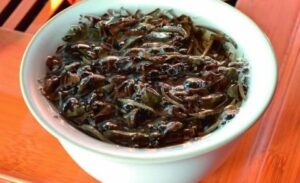In the East tea is treated with the same veneration and sophistication as Europe affords the ruby vintages of its vineyards. In the West a cup of tea is merely a soothing end to a long days work, or a wonderful way to spruce up a delicious breakfast; here its most extreme incarnation is found in the ritual of morning, afternoon or high tea, and while this may be an impressive development to centre around a simple infusion, the influence tea has had on the Far East is astounding.
The reader must understand that tea is an ancient institution in Asia. The earliest extant text on tea is the Cha Ching, literally the Book of Tea, though, men being inclined to drink and eat more than to write, it existed for a good while before Lu Yu set down the joys of tea to paper. A century later another Lu set down the wonders of tea in verse:
The first cup caresses my dry lips and throat,
The second shatters the walls of my lonely sadness,
The third searches the dry rivulets of my soul to find the stories of five thousand scrolls.
With the fourth the pain of past injustice vanishes through my pores.
The fifth purifies my flesh and bone.
With the sixth I am in touch with the immortals.
The seventh gives such pleasure I can hardly bear.
The fresh wind blows through my wings
Such are the words of Lu Tong; and yet the obsession with tea does not end in the depths of poesy. It becomes now a cult – an entire ceremony is developed about its preparation and presentation, as elaborate as the Catholic Eucharist. In Japan this ceremony is elevated to the state of a true religion in Sado (The Way of Tea), and is considered to be a code of rules and action that can lead to transcendental state of mind.
It is no strange thing then that tea comes in as many variations and types as wine. Tea connoisseurs mull over which season the tea was picked in. Was the tea picked before or after rain? What elevation was it grown at? In what soil did it prosper? What part of China or India was it grown in? These and many other concerns will be voiced over the subject of a tea. Of principle concern is the degree of tea fermentation (or lack thereof) which is analogous to the species of grape used in wine. The type of tea is therefore determined by its degree of fermentation and there are 5 types:
1. Green teas – Unfermented
2. Oolong tea – Semi fermented
3. Black tea – Fully fermented
4. White tea – The unfermented buds of the tea plant
5. Yellow tea – Unfermented but allowed to age slightly
Some connoisseurs consider Pu-erh to be a sixth type of tea. Tea prices can vary from affordable to equivalent with some of the finest wines. Below are some of the most expensive teas that are produced in the world:
Yellow Gold Tea Buds
If you think the cult of champagne is prestigious this tea will make you think again. Harvested on a single day in a small area of one mountain, the tea leaves of this blend are cut in same manner as those of the ancient Chinese emperors – with golden scissors used to fell only the buds and the first leaf of each growth. The tea is then sun dried and left to wilt in closed containers before finally being lightly painted with 24 ct gold.
The price itself also bests that of most champagnes – the tea sells for 3000 US dollars per kg.
Panda Dung Tea
Coffee has its Kapa Luwak blend that is made by processing coffee beans that have been eaten and egested by Asian civets which, purportedly, offers a superior taste versus regular coffee. Tea production has a similar concotion: Panda Dung Tea. While no tea is semi-digested in the bowels of China’s precious pandas, the tea is made using panda dross as a fertiliser. The tea itself is exceptionally flavourful and its exotic cultivation burgeons its price even further.
This premium tea sells for 70 000 USD dollars per kg.
Da-Hong Pao Tea
We have now come to the emperor of teas. Da-Hong Pao is perhaps the only plant ever to be honoured by any head of state. Legend posits that four tea trees on Mount Wu-Yi yielded a crop that cured a Ming emperors mother of a debilitating disease. Thankful to the plants, the emperor sent four large red robes to clothe the trees in honour; such a singular event in history lent itself to the name of the tea blend which means “Big Red Robe”.
Of the four bushes only three now remain, perched high up on the rocks of mount Wu-Yi. The tea itself does seem to have medicinal properties and those who have drunk it say that its taste is immaculate. The tea itself is generally only given to honour guests of the country and seen by some as a National Treasure. It is almost impossible to find but if you have deep pockets you can enjoy this greatest of all teas which sells for 1.2 million US dollars per kg.
Interested in tea? You can find a range of exciting teas on bidorbuy! We also have a range of beautiful antique tea-ware to complement the beverage.









